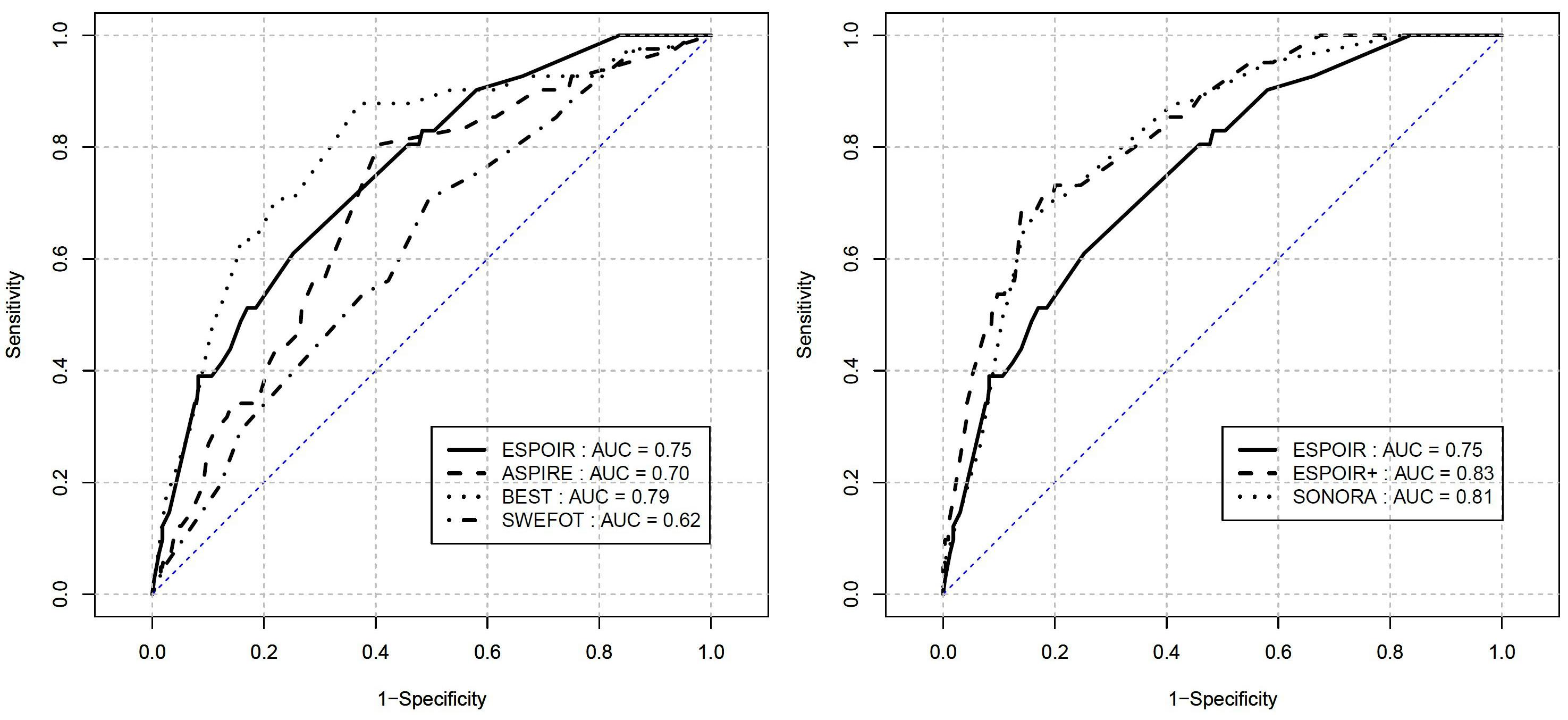Session Information
Session Type: Abstract Submissions (ACR)
Background/Purpose: Rapid radiographic progression (RRP) – i.e., increase of the Sharp/van der Heijde score (vSHS) ≥ 5 points during the 1st year – is a marker of poor prognosis in early rheumatoid arthritis (ERA). The study aims to test the validity of five matrices have been proposed recently (ASPIRE1, BEST2, SWEFOT3, ESPOIR4, SONORA5).
Methods: Between 2002 and 2005, the ESPOIR cohort enrolled 813 patients with recent arthritis in at least 2 joints with 6 weeks to 6 months disease duration. During the 2 first years of follow-up, patient data were collected every 6 months and structural damage progression on X-ray was measured by the vSHS. For the purpose of the study, only patients treated with methotrexate or leflunomide for ≥ 3 months within the 1st year of follow-up were selected. Baseline radiographic damage was assessed either by the present of RA erosions (at least 1 or more than 3) or vSHS value.
The validity of the different matrices, i.e., the capacity of the matrices to efficiently identify RRP patients at 1 year, was tested by Receiver Operation Curve (ROC) analysis in which the area under the curve (AUC) reflected the discriminating power of each matrix.
Results: 398 ESPOIR patients started MTX or leflunomide during the 1st year. Their main characteristics were: mean age 49.3 yrs, female 73.6%, FR+ or ACPA+ 62%, typical RA erosion 18.1% (central reading), ACR/EULAR 2010+ 86.4%, mean DAS28 5.35, mean swollen joint count 8.1, mean tender joint count 8.9, mean CRP 25.4 mg/L, mean HAQ 0.27. During the 1st year, the mean vSHS progression was 1.7 ±5.0 and 46 patients (11.6%) were classified RRP.
The performance of the ASPIRE and SWEFOT matrices displayed only moderate validity in the ESPOIR population, with AUC below 0.7 (Figure). The BEST matrix seems to perform optimally and its AUC was in the same range of the ESPOIR matrix, with an AUC of 0.79 and 0.75 respectively. The matrices using baseline vSHS value (ESPOIR+ and SONORA) displayed higher discriminating power than that using erosion information.
Conclusion: The BeSt matrix performs adequately in the ESPOIR cohort. However, the matrices using vSHS instead of erosion status seem to display higher discriminating power to identify ERA patients with RRP despite initial MTX or leflunomide therapy.
1Vastesaeger N. et al, Rheumatology(Oxford) 2009. 2Visser K. et al, Ann Rheum Dis 2010. 3Saevarsdottir S. et al, ACR 2011.(Abs 2513). 4Fautrel B. et al, ACR 2011 (Abs 353). 5Bombardier C. et al, ACR 2009.
.
Figure : ROC analysis assessing the performance of the 4 matrices
Disclosure:
B. Fautrel,
None;
B. Granger,
None;
B. Combe,
None;
F. Guillemin,
None;
A. Saraux,
None;
X. Le Loët,
None.
« Back to 2012 ACR/ARHP Annual Meeting
ACR Meeting Abstracts - https://acrabstracts.org/abstract/value-of-matrices-developed-to-identify-early-rheumatoid-arthritis-patients-with-rapid-radiographic-progression-despite-methotrexate-therapy-a-comparison-of-their-performance-in-the-early-rheumatoid/

